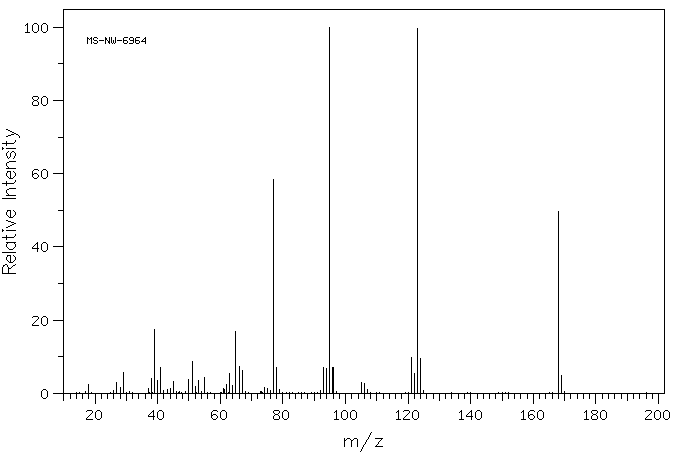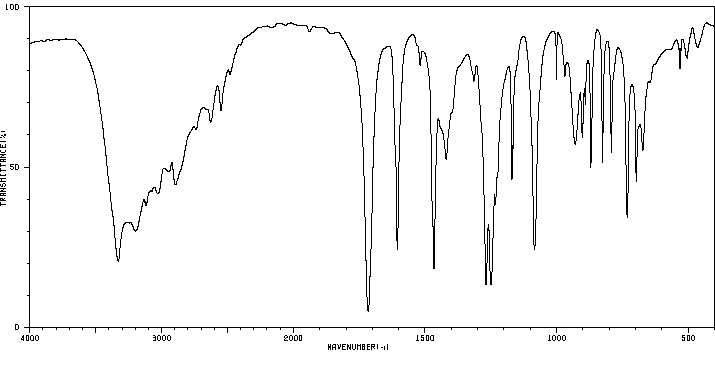n-(2,5-Dimethylphenyl)-2-nitrobenzamide | 102630-96-6
中文名称
——
中文别名
——
英文名称
n-(2,5-Dimethylphenyl)-2-nitrobenzamide
英文别名
——
CAS
102630-96-6
化学式
C15H14N2O3
mdl
——
分子量
270.288
InChiKey
IGUIIBFKJFKXRE-UHFFFAOYSA-N
BEILSTEIN
——
EINECS
——
-
物化性质
-
计算性质
-
ADMET
-
安全信息
-
SDS
-
制备方法与用途
-
上下游信息
-
文献信息
-
表征谱图
-
同类化合物
-
相关功能分类
-
相关结构分类
物化性质
-
熔点:173-175 °C(Solv: benzene (71-43-2))
-
沸点:355.1±42.0 °C(Predicted)
-
密度:1.270±0.06 g/cm3(Predicted)
计算性质
-
辛醇/水分配系数(LogP):3.3
-
重原子数:20
-
可旋转键数:2
-
环数:2.0
-
sp3杂化的碳原子比例:0.13
-
拓扑面积:74.9
-
氢给体数:1
-
氢受体数:3
上下游信息
-
下游产品
中文名称 英文名称 CAS号 化学式 分子量 2-氨基-N-(2,5-二甲基苯基)苯甲酰胺 2-Amino-n-(2,5-dimethylphenyl)benzamide 102630-80-8 C15H16N2O 240.305
反应信息
-
作为反应物:描述:n-(2,5-Dimethylphenyl)-2-nitrobenzamide 在 sodium hydroxide 、 锌 作用下, 以 甲醇 、 水 为溶剂, 反应 15.0h, 以36%的产率得到2-苯基-1,2-二氢-3H-吲唑-3-酮参考文献:名称:Potent, Selective, and Orally Available Benzoisothiazolone Phosphomannose Isomerase Inhibitors as Probes for Congenital Disorder of Glycosylation Ia摘要:We report the discovery and validation of a series of benzoisothiazolones as potent inhibitors of phosphomannose isomerase (PM), an enzyme that converts mannose-6-phosphate (Man-6-P) into fructose-6-phosphate (Fru-6-P) and, more importantly, competes with phosphomannomutase 2 (PMM2) for Man-6-P, diverting this substrate from critical protein glycosylation events. In congenital disorder of glycosylation type Ia, PMM2 activity is compromised.; thus, PMI inhibition is a potential strategy for the development of therapeutics. High-throughput screening (HTS) and subsequent chemical optimization led to the identification of a novel class of benzoisothiazolones as potent PMI inhibitors having little or no PMM2 inhibition. Two complementary synthetic routes were developed, enabling the critical structural requirements for activity to be determined, and the compounds were subsequently profiled in biochemical and cellular assays to assess efficacy. The most promising compounds were also profiled for bioavailability parameters, including metabolic stability, plasma stability, and permeability. The pharmacokinetic profile of a representative of this series (compound 19; ML089) was also assessed, demonstrating the potential of this series for in vivo efficacy when dosed orally in disease models.DOI:10.1021/jm101401a
-
作为产物:描述:2,5-二甲基苯胺 、 2-硝基苯甲酰氯 在 potassium carbonate 作用下, 以 四氢呋喃 为溶剂, 反应 12.0h, 以61%的产率得到n-(2,5-Dimethylphenyl)-2-nitrobenzamide参考文献:名称:Anticonvulsant activity of 2- and 3-aminobenzanilides摘要:A series of 2- and 3-aminobenzanilides derived from ring-alkylated anilines were prepared and evaluated for anticonvulsant activity. These benzanilides were prepared in the course of studies designed to determine the relationship between the benzamide structure and anticonvulsant effects. The compounds were tested in mice against seizures induced by maximal electroshock (MES) and pentylenetetrazole and in the rotorod assay for neurologic deficit. The 3-aminobenzanilide derived from 2,6-dimethylaniline, 21, was the most potent anti-MES compound, with an ED50 of 13.48 mg/kg and a protective index of 21.11 (PI = TD50/ED50). The activity profile for 21 compares favorably with that for phenobarbital and phenytoin.DOI:10.1021/jm00158a038
文献信息
-
CLARK C. R.; LING CHING-MING; SANSOM R. T., J. MED. CHEM., 29,(1986) N 8, 1534-1537作者:CLARK C. R.、 LING CHING-MING、 SANSOM R. T.DOI:——日期:——
-
BENZOISOTHIAZOLONES AS INHIBITORS OF PHOSPHOMANNOSE ISOMERASE申请人:Cosford Nicholas D. P.公开号:US20110257233A1公开(公告)日:2011-10-20The disclosure provides new compounds and compositions thereof, and methods for treating or ameliorating a disorder relating to CDG-Ia. In particular, the disclosure provides benzoisothiazolone inhibitors of PMI, which have been synthesized and their ability to drive glycosylation has been demonstrated. The disclosure provides two synthetic routes for these compounds, including a new copper-catalyzed N-arylation reaction amenable to parallel derivitization. The disclosed compounds represent potent inhibitors of PMI, and their dose-dependent efficacy in cell-based models of glycosylation have been demonstrated. In addition, the disclosed compounds are selective over PMM and therefore, are useful in treating or ameliorating a disorder relating to CDG-Ia.
表征谱图
-
氢谱1HNMR
-
质谱MS
-
碳谱13CNMR
-
红外IR
-
拉曼Raman
-
峰位数据
-
峰位匹配
-
表征信息
同类化合物
(βS)-β-氨基-4-(4-羟基苯氧基)-3,5-二碘苯甲丙醇
(S,S)-邻甲苯基-DIPAMP
(S)-(-)-7'-〔4(S)-(苄基)恶唑-2-基]-7-二(3,5-二-叔丁基苯基)膦基-2,2',3,3'-四氢-1,1-螺二氢茚
(S)-盐酸沙丁胺醇
(S)-3-(叔丁基)-4-(2,6-二甲氧基苯基)-2,3-二氢苯并[d][1,3]氧磷杂环戊二烯
(S)-2,2'-双[双(3,5-三氟甲基苯基)膦基]-4,4',6,6'-四甲氧基联苯
(S)-1-[3,5-双(三氟甲基)苯基]-3-[1-(二甲基氨基)-3-甲基丁烷-2-基]硫脲
(R)富马酸托特罗定
(R)-(-)-盐酸尼古地平
(R)-(-)-4,12-双(二苯基膦基)[2.2]对环芳烷(1,5环辛二烯)铑(I)四氟硼酸盐
(R)-(+)-7-双(3,5-二叔丁基苯基)膦基7''-[((6-甲基吡啶-2-基甲基)氨基]-2,2'',3,3''-四氢-1,1''-螺双茚满
(R)-(+)-7-双(3,5-二叔丁基苯基)膦基7''-[(4-叔丁基吡啶-2-基甲基)氨基]-2,2'',3,3''-四氢-1,1''-螺双茚满
(R)-(+)-7-双(3,5-二叔丁基苯基)膦基7''-[(3-甲基吡啶-2-基甲基)氨基]-2,2'',3,3''-四氢-1,1''-螺双茚满
(R)-(+)-4,7-双(3,5-二-叔丁基苯基)膦基-7“-[(吡啶-2-基甲基)氨基]-2,2”,3,3'-四氢1,1'-螺二茚满
(R)-3-(叔丁基)-4-(2,6-二苯氧基苯基)-2,3-二氢苯并[d][1,3]氧杂磷杂环戊烯
(R)-2-[((二苯基膦基)甲基]吡咯烷
(R)-1-[3,5-双(三氟甲基)苯基]-3-[1-(二甲基氨基)-3-甲基丁烷-2-基]硫脲
(N-(4-甲氧基苯基)-N-甲基-3-(1-哌啶基)丙-2-烯酰胺)
(5-溴-2-羟基苯基)-4-氯苯甲酮
(5-溴-2-氯苯基)(4-羟基苯基)甲酮
(5-氧代-3-苯基-2,5-二氢-1,2,3,4-oxatriazol-3-鎓)
(4S,5R)-4-甲基-5-苯基-1,2,3-氧代噻唑烷-2,2-二氧化物-3-羧酸叔丁酯
(4S,4''S)-2,2''-亚环戊基双[4,5-二氢-4-(苯甲基)恶唑]
(4-溴苯基)-[2-氟-4-[6-[甲基(丙-2-烯基)氨基]己氧基]苯基]甲酮
(4-丁氧基苯甲基)三苯基溴化磷
(3aR,8aR)-(-)-4,4,8,8-四(3,5-二甲基苯基)四氢-2,2-二甲基-6-苯基-1,3-二氧戊环[4,5-e]二恶唑磷
(3aR,6aS)-5-氧代六氢环戊基[c]吡咯-2(1H)-羧酸酯
(2Z)-3-[[(4-氯苯基)氨基]-2-氰基丙烯酸乙酯
(2S,3S,5S)-5-(叔丁氧基甲酰氨基)-2-(N-5-噻唑基-甲氧羰基)氨基-1,6-二苯基-3-羟基己烷
(2S,2''S,3S,3''S)-3,3''-二叔丁基-4,4''-双(2,6-二甲氧基苯基)-2,2'',3,3''-四氢-2,2''-联苯并[d][1,3]氧杂磷杂戊环
(2S)-(-)-2-{[[[[3,5-双(氟代甲基)苯基]氨基]硫代甲基]氨基}-N-(二苯基甲基)-N,3,3-三甲基丁酰胺
(2S)-2-[[[[[((1S,2S)-2-氨基环己基]氨基]硫代甲基]氨基]-N-(二苯甲基)-N,3,3-三甲基丁酰胺
(2S)-2-[[[[[[((1R,2R)-2-氨基环己基]氨基]硫代甲基]氨基]-N-(二苯甲基)-N,3,3-三甲基丁酰胺
(2-硝基苯基)磷酸三酰胺
(2,6-二氯苯基)乙酰氯
(2,3-二甲氧基-5-甲基苯基)硼酸
(1S,2S,3S,5S)-5-叠氮基-3-(苯基甲氧基)-2-[(苯基甲氧基)甲基]环戊醇
(1S,2S,3R,5R)-2-(苄氧基)甲基-6-氧杂双环[3.1.0]己-3-醇
(1-(4-氟苯基)环丙基)甲胺盐酸盐
(1-(3-溴苯基)环丁基)甲胺盐酸盐
(1-(2-氯苯基)环丁基)甲胺盐酸盐
(1-(2-氟苯基)环丙基)甲胺盐酸盐
(1-(2,6-二氟苯基)环丙基)甲胺盐酸盐
(-)-去甲基西布曲明
龙蒿油
龙胆酸钠
龙胆酸叔丁酯
龙胆酸
龙胆紫-d6
龙胆紫








